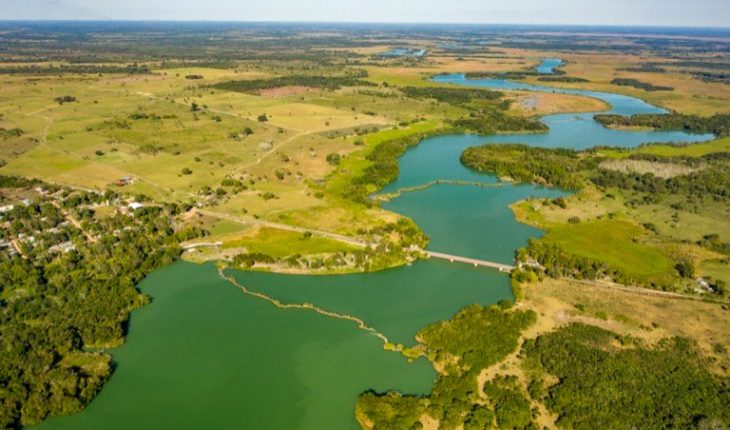Exequiel Ezcurra had doubts when he first heard Carlos Burelo-Ramos, a botanist at the University of Mexico in Tabasco, talk about the possibility of mangroves on the San Pedro Mártir River in southern Mexico. The red mangrove (Rhizophora mangle) inhabits freshwater environments — the Bay of Pigs in Cuba and the Florida Everglades are two prominent examples.
However, mangroves that are at least 170 kilometers inland? That seemed unlikely.
“You probably got their botanical identification wrong because it doesn’t seem plausible that mangroves would grow in a freshwater river at such a distance from the coast,” Ezcurra, an ecology professor at the University of California, Riverside, told Burelo-Ramos.
Read: Mangroves in danger: this has been the destruction of these ecosystems in Mexico
However, a confident Burelo-Ramos responded and respectfully told Ezcurra, “I’m a good taxonomist. I know my plants and this is red mangrove.”
“That piqued my curiosity,” Ezcurra told Mongabay. Indeed, on a trip to San Pedro Mártir with his daughters he found red mangrove, which, unlike other mangrove species growing in the Gulf of Mexico, can settle in habitats that lack salt, at least the variety of sodium chloride dominant in the world’s oceans. The trees exist on a calcium-rich limestone known as karst, which previous research has shown supports salt-loving mangrove trees.
However, the red mangrove was not the only species that inhabits the coast that it found in the middle of the state of Tabasco, at the base of the Yucatan Peninsula. He found coastal palms and rosewoods, golden leather fern (Acrostichum aureum), uben amigo (Coccoloba barbadensis) and the flower orchid (Myrmecophila tibicinis). In short, it was as if “an entire coastal ecosystem” had been transplanted from the Gulf of Mexico to this place on the San Pedro Mártir River.
Ezcurra’s first step was to get back in touch with Burelo-Ramos. “You’re absolutely right,” he said. “We should study what’s going on.”
The interdisciplinary team they assembled uncovered not only how the ecosystem came to this place, but also new perspectives on the power that a changing climate can exert over all forms of life, including us. Their findings, published Oct. 12 in the scientific journal Proceedings of the National Academy of Sciences, suggest that higher sea levels as a result of global melting — due to rising temperatures about 115,000 to 130,000 years ago — were responsible for the emergence of mangroves in this part of Mexico. Essentially, they thought this ecosystem was located on an ancient coastline in a warmer world.
Previous research has presented several “far-fetched hypotheses” to explain how mangroves ended up inland, Ezcurra said. Perhaps hurricanes or birds carried them inland. However, mangrove seeds are large and bitter, making it less likely that they arrived with the wind or in the belly of a bird. Others speculated that the Maya might have planted them here, but transporting them a couple of hundred kilometers inland would have required a lot of effort for little apparent benefit, Ezcurra said.
The mangroves’ own natural life cycle offered the team a more plausible route. Seedlings can float like corks in the water for a year or more before sinking to the bottom and casting a tangle of roots into muddy coastal soils. Ezcurra and his companions wondered if the waters of the Gulf of Mexico could have risen high enough to carry mangrove seeds to where they exist today in the San Pedro Mártir River.
“Was there an event where the ocean could have risen 10 meters above the level we have now?” said Ezcurra.
A stand of red mangroves is located in the calm fresh, calcium-rich waters of the San Pedro Mártir River, Tabasco, Mexico. Image by Ben Meissner.
They knew that, just over 100,000 years ago, glaciers, ice caps, and ice sheets had retreated during a surge of warm temperatures — what scientists call the last interglacial period during the Pleistocene period. That thaw led to a rise of between 6 and 9 m (20-30 ft) of sea level, potentially enough to explain the current position of the mangroves. Later, computer modeling suggested that this was a likely scenario.
Still, the team wanted more evidence to bolster this “working hypothesis,” Ezcurra said. For example, could they show that the mangWere the reds in the San Pedro Mártir related to those that existed downstream?
To answer this question, the team probed the trees’ DNA and compared it to red mangrove populations around the Yucatan Peninsula. In fact, the results showed that mangroves on the banks of the San Pedro Mártir River were more similar to those found along the margins of the Gulf of Mexico, rather than to red mangroves on the Caribbean side of the peninsula.
However, his analysis does not end there. By digging down to the level of DNA bases, those chemical compounds that are the basis for subtle (and sometimes not so subtle) differences within and between species, the team was able to determine when coastal and riparian mangrove variants had long since separated from each other. The team was using the plant’s genetic code as a “molecular clock,” Ezcurra said.
“There is a complete Pleistocene history written in DNA,” he said. The analysis then pinned the time of division at around 100,000 years ago, except for a few thousand years. In other words, it was within the space of time during which a new glaciation began, brought on by colder temperatures.
The researchers also examined sediments in the mangrove area at the San Pedro Mártir. The rounded gravel they found in local quarries looks more like what you’ll find in the ocean than in a riverbed. They also noted the presence of oyster shells that are indistinguishable from the ubiquitous Virginia oyster (Crassostrea virginica) which, to this day, frequents estuaries along the Gulf. These findings led the researchers to conclude “unequivocally” that mangroves exist at the edges of what was once an ancient coastal lagoon and conspire to leave behind this “relic” of a different time on our planet.
However, more recently, the persistence of the mangrove ecosystem in san Pedro Mártir was much less certain. In the 70s, the drive to hand over the forests of Central and South America to agriculture and pasture found its way to Tabasco. Most of the state’s forests were cut down, but the team’s bulldozers were hampered by the mangrove swamp soils and left them as they were.
However, the farms that replaced them soon came to a standstill once the thin top layer of fertile soil found in the ancient rainforests dried up.
“Behind them are only eroded fields where magnificent rainforests once grew,” Ezcurra said. “It’s a tragic story of misguided development.”
The decline of the landscape has left Tabasco’s population impoverished, he said.
“It’s a truly sad story,” Ezcurra said, “but we’d like to think that maybe the findings in the San Pedro River will bring a hopeful note.”
Mangroves are still there, their twisted root systems that hold the banks of the river and help supply clean water for the population that remains there. And, as they do along coasts around the world, they incubate populations of fry that serve as an important food source.
They serve as a reminder of the important services mangroves provide wherever they are located, Ezcurra said. Still, the discovery of how they ended up along the San Pedro Mártir River is also an omen, foreshadowing how the current round of climate change could alter the face of the world we inhabit.
“We should take these things more seriously, without being alarmist,” Ezcurra said. “Sea level rise is happening.”
This work was originally published on Mongabay
What we do at Animal Político requires professional journalists, teamwork, dialogue with readers and something very important: independence. You can help us keep going. Be part of the team.
Subscribe to Animal Político, receive benefits and support free journalism.#YoSoyAnimal





